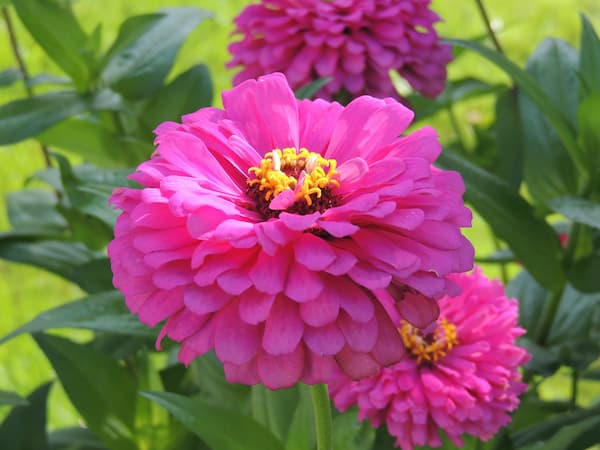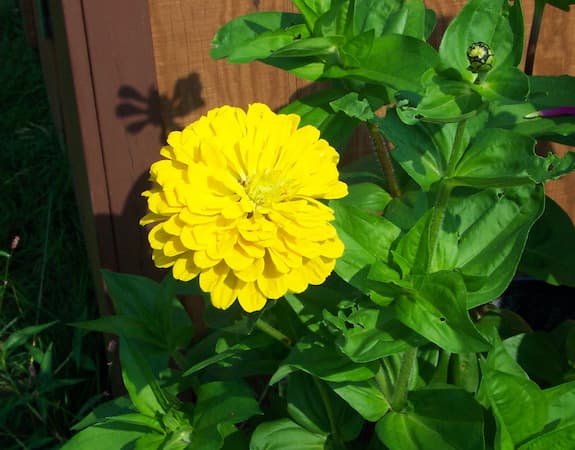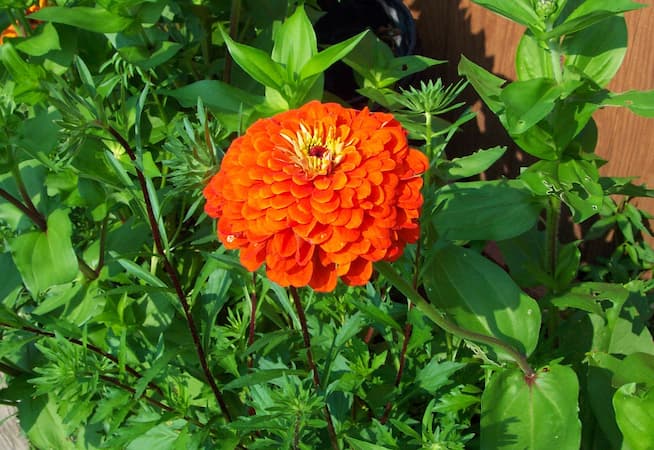How to Grow Zinnia Flowers

About Growing Zinnia Flowers in Your Home Garden
Zinnias are a really neat flower, that is very popular in home flower gardens. As a matter of fact, it’s one of the most popular flowers in home gardens. Zinnia plants are native to warm regions of Central and South America. However, they grow well in most hardiness zones. Zinnias come in a wide variety of colors with large, profuse blooms. Flowers will bloom from mid-summer all the way until frost. And, annual Zinnias are an easy-to-grow flower. Use this guide on “How to Grow Zinnia Flowers” and you’re on your way to growing some fantastic flowers!
The plants are deer resistant, too.
Zinnias make good-cut flowers for indoor arrangements.

Zinnia Flowers Plant Specifications
Flower Colors: Zinnia flowers include almost all colors of the rainbow and in varying shades. The exceptions are black and white.
Flowers Bloom: Summer thru to the first Fall frost.
Plant Height: Miniature varieties grow as small as six to eight inches tall. The largest varieties grow from three to four feet tall. 4 feet.
Ideal Soil pH: 5.5 – 7.5.
Plant Hardiness Zones: 2 – 11
Light Needs: Bright, full sunlight.
Toxic Plant?: No.
Deer Resistant? Yes. The plants have a strong scent and harsh texture. As a result, deer, rabbits, and other foraging animals avoid it.
Number of Species: 24 species.
Plant Type: Annuals
Native To: North, Central, and South America.
Botanical Name: Zinnia elegans
Are Zinnias Edible?
YES!!
Zinnia plants are safe to eat for humans, pets, farm animals, and wild animals, too. The plant can be consumed raw or cooked. Some sources suggest removing the seeds before cooking them. this is because the seeds have a bitter taste.

Medicinal Uses for Annual Zinnias Plant
Zinia plants have a number of medicinal properties. They are rich in healthy flavonoids. And, they include anti-inflammatory, anti-bacterial, and anti-viral compounds. Some of the medicinal applications include:
- Use it to treat eczema and psoriasis.
- It can treat acne conditions.
- Eases the symptoms of coughs and colds.
- Use it in lotion form to treat cuts, scrapes, and wounds.

Light Requirements
For the biggest, brightest, and most prolific blooms, grow Zinnia flowers in full, direct sunlight. Select a growing location where the plants will receive eight to ten hours of bright sunlight. Full sun will also help to deter plant disease, most notably powdery mildew.
Zinnia Flowers Aplenty!
Seed companies offer a wide variety of Zinnias in a vast array of colors. Certainly, there’s at least one variety to fit every flower gardener and every need. There is a profusion of colors, multi-colors, and hues. Colors include white, yellow, orange, red, rose, pink, and multi-colored blooms. There are miniature and giant varieties ranging in size from about a foot for miniatures to giant varieties that can grow over three to four feet tall!
Select the color and size Zinnia, that is perfect for your flower garden. If you are planning a container garden, make sure to include some miniature zinnias.
For more information, see: Popular Zinnia varieties

Annual Zinnia Plant Propagation
Zinnias are grown from seed. Zinnia seeds can be directly seeded into your flower garden, or seeded indoors for transplanting later. We recommend planting Zinnia seeds in pots and containers indoors, then transplanting them outdoors. This allows you to make the proper spacing and not have to thin seedlings.
Sow Zinnia seeds early in the season and cover lightly with soil. Water thoroughly once. The seeds germinate easily, and grow quickly, producing their first of a continual display of blooms, by mid-summer.
Transplant young Zinnia plants into your garden after the last frost date for your area. Spacing depends upon the size, with miniature varieties spaced four to six inches apart, and Giant varieties one to two feet apart.
Final Plant Spacing: Plant zinnias from four to twenty-four inches apart, depending upon variety. Obviously, space the smallest varieties just a few inches apart. while the giant varieties need 24 inches between plants for the best performance and healthiest plants.
Days to Germination: 5 – 10 days.

How to Grow Zinnia Flower Plants
Plant Location and Soil Needs:
Growing Annual Zinnias is a cinch! They are one of the easiest flower plants to grow in your home flower garden.
Grow plants in full sun. In hotter areas of the country, they will do well in light afternoon shade. The plants like warm to hot weather.
Zinnia plants like rich, well-drained soil. But, with the addition of a regular fertilizer routine, they are very tolerant of average to slightly poor soils. Improving your soil quality will produce much healthier plants and more flowers. So, add plenty of compost the first time you plant them.
Once Zinnia plants are established, they should grow well. Soil should be moist, but not wet.
Fertilizer Needs:
Beginning in early Spring, apply a general-purpose fertilizer once a month, especially with average soils. Just before the blooming period, switch to a fertilizer high in phosphorous to promote lots of big and bright blooms.
You can apply a liquid fertilizer to the leaves, too. However, do so only in the morning when the leaves can dry quickly.
Water Needs:
Water plants during dry periods, once or twice per week. The roots can go down 12 to 24 inches. So, water the plants deeply. It is important to keep the leaves dry to avoid plant disease. So, make sure to apply water directly to the soil and not on the leaves.
Also.....
Keep the planting area well-weeded, especially for smaller varieties.
Add mulch around the plants for a tidy appearance, and to keep weeds down.
Taller varieties made need staking to help keep the heavy blooms upright.
Around mid-summer, your Zinnia plants will begin to produce flowers. The blooms will continue, up to the first frost. Remove dead flower blooms, to encourage new growth and blooms. Improve the appearance of Giant Zinnias, by trimming back stems that have grown long or gangly. However, do not over trim the plants.
Zinnias are annuals and are susceptible to frost. They may survive the first light frost with only a little damage. They will not survive a hard frost or freeze.
Harvesting Seeds


Zinnias are Great Cut Flowers
Giant Annual Zinnias have long stalks for flower vases and other arrangements. Cut the stem low, check for insects hiding in the flower head, on the stem, and under the leaves. Bring them indoors and place them in water immediately.
For miniature varieties like Lilliput with their button blooms, use a small container or vase and cut the stem a couple of inches long. Bunch up a variety of colors for an eye-appealing arrangement. Then, add a small sprig or two of Baby’s Breath for accent.

How to Grow Zinnia Flowers in Containers
Bright and attractive annual Zinnias are a perfect selection to grow in flowerpots or containers on your balcony, or deck. Plant them in a container and watch them grow!
Like any container-grown plant, they need a little more care and attention. In addition to normal plant care, here’s how to grow annual zinnia flowers in containers:
- As previously mentioned, Zinnia plants look good growing together in groups. Smaller varieties tolerate a little crowding.
- Select a sunny to partly sunny location on your deck.
- It is important to have a drain hole in the container to allow excess water to drain from the pot.
- Keep an eye on the moisture level. Check the plants every few days, especially in extended periods of hot, dry weather.
- Keep the soil consistently moist, but not wet. Let the top of the soil begin to dry between watering.
- When watering the plants, thoroughly wet the soil. Excess water will drain through the hole in the bottom of the flowerpot.
- Nutrients in a flowerpot are limited. So, use fertilizer spikes to feed the plants. Or, apply a light solution of liquid fertilizer once a month.
Pruning Zinnia Flowers
- It is important to prune annual Zinna plants. There are several steps to your pruning regimen.
First, Remove any dead, damaged, or diseased leaves and stems as soon as you spot them. - Second, do not let the foliage get too dense. Thin the plants out as needed, to improve air circulation This helps to minimize or avoid powdery mildew and other plant diseases.
- Late in the season, the stems can become leggy. Trim them back. But, don’t be too aggressive.
- Deadhead spent blooms. This encourages the plant to produce new blooms and extends the blooming period.
More on deadhead spent flower blooms.

Insects and Plant Disease
Zinnias are somewhat resistant to insects. If insect or disease problems occur, treat early with organic or chemical insect repellents, as needed.
Zinnia plants are quite susceptible to powdery mildew in humid weather. Apply a fungicide at the first sign of powdery mildew.
Also see: Plant Problems – Identify the causes and find the cures.
Related Articles
Also, people who read this article on How to Grow Zinnia flowers will like:
How to Grow Zinnia Flower Plants – By Garden Hobbies.
Zinnia Flower Gallery – pictures for your personal and non-profit use,
Please support our site. Shop for:
- rmmatthews100@hotmail.com
- 585-721-6528
- Rochester, NY
©1999-2024 GardenersNet.Com, All Rights Reserved

